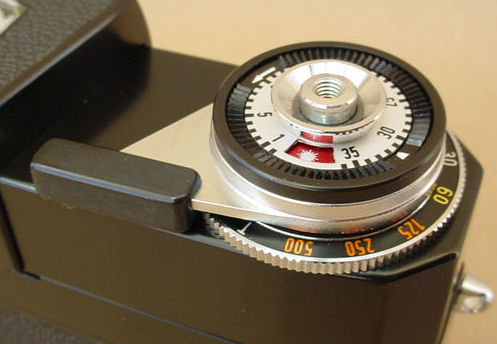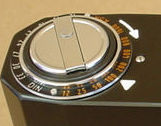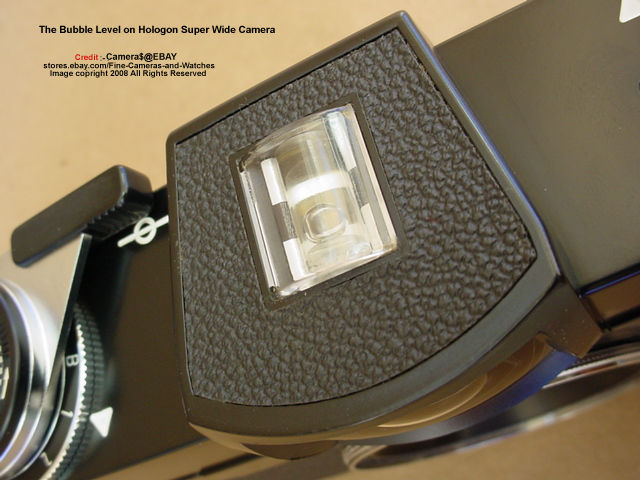|
Basic Technical Specification:
Type:-Film based 35mm mechanical camera; Film format: 35 x 24mm; Material:
largely Metal construction
Interchangeable lenses: No. Fixed lens type w/fixed aperture; Lens mount:-
Not relevant;
Shutter Speeds Range: 1 sec ~ 1/500 sec., B (bulb) and T (time exposure); Shutter:
Cloth type;
Viewfinder: Fixed, optical viewfinder type, above the lens, on axis with
bubble level indication visible inside finder;
Synch: Provided, universal PC-type; Film Back: Removable, rangefinder
camera type;
Lens: 3 elements HOLOGON design, Fixed, no diaphragm, fixed aperture of
f/8.0; Picture angle coverage: approx. 110°
Film Advance: via Film advance lever; Rewinding via film rewind crank/knob
Dimension: approx. 44.4mm (D) x 150.24mm (W) x 8.89mm (H) (1.75" x 3.5"
x 6"); Weight: approx., 750g (body & lens)
Bubble level: Provided on top of camera panel; Tripod Socket: Provided at
the base section of the camera
Accessories: Hand Grip, cable release, lens cap (internal Thread); leather
all-in-one compartment case, instruction manuals; boxes
Optional Accessories:- Center graduated optical filter; magazine backs etc. |
| |
 |
Oh.. what a camera and a lens here...
Credit: Image courtesy of camera$@EBAY®.
He also operates a popular
EBAY STORE where he often lists many used RARE pieces of Nikon, Leica and other
old classic photo equipment, Images are also well taken for visual confirmation for
buyers - he is also one of my favorite bookmark Ebay dealer. Image copyright ©
2006. All rights reserved. Please respect the visual property of the contributing
photographer.
|
| The ultra-wideangle lens itself on the HOLOGON ultrawide
camera is not large in physical dimension and in fact, the optical viewfinder which
was positioned just above the lens and occupied at the mid section of the prism area
is more pronouncing than the lens itself. So, Zeiss has designed the lens with a
larger diameter at the lens section to offset this area. Secondly, this has a lot
to to with the protruding external lens element of the Hologon lens at the front,
where the exposed optic can also be protected via design of a circular metal outer
ring built around the Hologon lens. The entire camera is not as big as you thought
it should be, as the depth of the camera only measures approx. 45mm deep, this is
because the rear lens element is only 4.5mm away from the film plane and since there
is no reflex housing as in the case of a SLR camera, so, much space has been saved
to keep the dimension down. The HOLOGON ultrawide camera is ALL ABOUT the lens and
you can quote it is a camera Zeiss has built for the lens rather than in conventional
manner that manufacturers designed cameras to accommodate many types and varieties
of lenses and probably for the ultimate collectors, this is one good reason why this
camera is so special. |
| |
| The shutter is entirely mechanical, offers a range of
shutter speeds from 1/500sec down to 1 sec. As the aperture is fixed @ f/8.0 you
can only adjust exposure setting via manipulating shutter speeds, something like
a "mechanical way of shutter speed priority". There is no built-in meter
reading, so use of handheld meter and/or guess exposure like the sunny 16 rules are
applied. For practical reasons with a slow f/8.0 fixed aperture, Zeiss offered slower
shutter speed control is important. The camera offers slowest camera set speed of
1 sec. and supplemented with two B & T settings. One requires shutter lock (handheld
or lockable cable release) and the next doesn't. Even reasons given makes good rational
and acceptable, I am not sure why it is not offered with a 1/1000sec top shutter
speed. |
 |
The shutter speed dial or the film advance level section
is quite interesting. It is comprised in 4 levels. With shutter release button, threaded
to accept cable release; and a film exposure counter just under, with the film advance
lever next and located at the based is the shutter speed selection dial. The speed
settings marked from T, B, 1 sec, 1/2, 1/4, 1/8, 1/15, 1/30 sec. in white on a black
dial, 1/60 sec (maximum permissible sync speed) pained in yellow; top speeds 1/125,
1/250 and 1/500sec painted in orange. Despite all the controls are jammed into one
section, it is not confusing all and very friendly to use. Just at the end of the
film advance lever, Zeiss also provides an index for film plane.
|
| |
|
| However, as it is unlikely the camera is often used for
close range, critical focusing (where it actually can't because Hologon lens used
here on the camera is a fixed focus type); this is a less useful feature. Please
bear in mind the lens has NO focusing helical within and cannot adjust focusing as
conventional lenses. Due to optical nature as an ultra-wideangle lens which generates
immense depth of field, the HOLOGON ultrawide camera is literally need not have to
focus from 0.5m ~ infinity (OO). But it doesn't mean it has a focusing mechanism on the lens section
for user to adjust focus. For critical close range focusing, the film plane index
may come in handy but it is highly unlikely to be so demanding unless for scientific
usage. |
| |
|
 |
On the other side (left) of the camera top panel was
well utilized. Under the rather flat film rewind knob, you will find a film speed
reminder dial. As this is not an automatic camera, the film speed just serves as
a reminder for user of the film type being used in the camera. There is a large index
for film speed as well as another white arrow indicating directional rotation for
film rewinding guide.
|
 |
The center section of the Zeiss Ikon HOLOGON ultrawide
is not a pentaprism. It is actually an oversized optical viewfinder and made to be
an integrated component of the camera. Personally, I would think the Optical Finder
itself is also a stroke of genius from its creator. It is positioned just above the
lens, on axis. The front portion looks so distinctive even if its purpose was just
to provide visual guide for photographer with an estimate picture coverage.
|
| |
|
| Over the years, Zeiss has designed many optical viewfinders
for the Contax rangefinder bodies and the widest picture angle was believed to be
the dedicated 2.1cm
finder for the Zeiss Opton BIOGON 4.5/2.1cm
or the Turret Finder 440 universal finder which has the 2.1cm covered. Well,
although the number variation can be small, but jumping from 92° to
110° is a different story. Although the viewable
image exhibits very slight level of barrel distortion but overall, it does gives
a good preview. |
|
|
 |
More interesting is the inclusion of a bubble level rests
at the top of the finder. This is a very practical feature so as to assist photographer
to determine the film plane has been keeping absolute vertical to minimize perspective
distortion. Further, the bubble image was also visible inside the viewfinder and
user doesn't have to revert back to the top to check if the camera/lens stays perpendicular.
The bubble level design was still being used on the Contax revived G-spec Hologon 16mm f/8.0
for the original 1994 G1 and G2 in 1996.
<<<---
A very well captured photo of the Zeiss
Ikon Hologon ultrawide camera with essential components setup well arranged in an
angled arrangement shot.
Credit: Image courtesy
of Mr. Peter Coeln from LEICA
Shop®, Austria who also operates a popular
Westlicht Auction House. Image Copyright © 2008. All rights reserved. Please respect
the visual property of the contributing photographer.
Index
Page
| Part
One
| Part
Two |
Part
Three
| Part
Four
| Part
Five
previous | NEXT | 3/6
|
| |
Credit: Image courtesy of Mr. Peter Coeln
from LEICA Shop®, Austria who also operates a popular Westlicht Auction House as well as some of the primary Images courtesy
of camera$@EBAY® who also operates an EBAY STORE. Both online trade centres can find many
used RARE pieces of Nikon, Leica and other old classic photo equipment, ALL images
appeared herein belongs to the respective contributors and are copyright © 2008.
All rights reserved. Please respect the visual property of the contributing photographer.
|
|